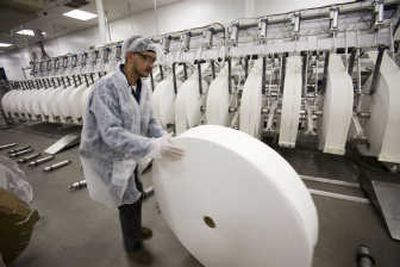Declines in manufacturing, construction fuel worries

NEW YORK – Further weakness in the manufacturing sector and construction industry underscored concerns that the U.S. economy has fallen into recession, though most analysts believe a downturn will be mild and relatively short-lived.
The Institute for Supply Management said Tuesday that manufacturing contracted for a second consecutive month in March as manufacturers grappled with weakening order books and rising prices for raw materials.
The institute’s manufacturing index registered 48.6 last month, a bit stronger than the 48.3 reading for February, which had been the weakest in five years.
Readings below 50 indicate contraction, while those above 50 show growth.
In Washington, the Commerce Department said that construction spending fell again in February as home building tumbled for a record 24th straight month.
The department said overall construction activity dropped 0.3 percent in February, reflecting weakness not only in home building but also in nonresidential activity. Only government building projects showed a gain for the month.
Gary R. Thayer, senior economist with Wachovia Securities, said the latest figures provided “more evidence that the economy is probably in recession.”
A recession is traditionally defined as two straight quarters of decline in economic output.
“The manufacturing sector is contracting, but not dramatically,” Thayer said.
“We’re also seeing, of course, weakness in housing. And it looks like consumer spending is starting to pull back a bit.”
While he expects a downturn in the first half of the year, he expects growth to resume in the second half after promised government tax rebates are distributed to an estimated 130 million American households.
The manufacturing report – along with rising hopes that banks hurt by the credit crisis were working through their problems – kicked off a rally on Wall Street.
Norbert Ore, chairman of the Institute for Supply Management’s manufacturing business survey committee, said in a statement that the March reading on manufacturing capped “the weakest quarterly performance for the U.S. economy since the second quarter of 2003.”
He cited weakness in orders and the backlog of orders and added: “Additionally, manufacturers continue to experience heavy cost pressures as the prices they pay are still rising, even with slower overall demand.”
The institute’s new orders index registered 46.5 in March, compared with 49.1 in February. Ore said it was the fourth consecutive month new orders failed to grow.
The price index, meanwhile, soared to 83.5 last month from 75.5 in February.
Daniel J. Meckstroth, chief economist for the Manufacturers Alliance/MAPI, a trade group based in Arlington, Va., said in a statement that he believes the manufacturing sector is in recession.
Still, Meckstroth said that the weak dollar, which has supported exports and weakened imports, as well as government stimulus programs “should keep the 2008 recession on the mild side for the industrial sector.”
The 0.3 percent drop in overall construction spending in February marked the fifth straight monthly decline.
Residential construction fell 0.9 percent in February and has dropped every month since March 2006, a record period of declines that underscored the severe downturn going on in housing.
Spending on nonresidential projects, meanwhile, dropped 0.1 percent in February following a 1 percent decline in January.
Government spending was the one area of strength, rising 0.4 percent with federal spending surging by 1.4 percent and state and local projects rising 0.4 percent.
Total construction spending dipped to $1.12 trillion at an annual rate in February, while private activity fell to $826.6 billion at an annual rate and government spending edged up to $294.9 billion at an annual rate.